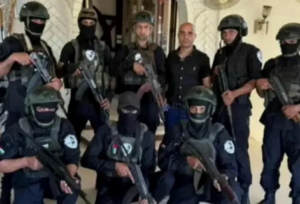‘Will blow up in our faces’- Israel using Gazan militias for military operations – for pay, territory

Members of the Abu Shabab militia.
Yaniv Kubovich reports in Haaretz on 17 September 2025:
The IDF and Shin Bet security service are using Gaza-based militias to carry out military operations in exchange for pay and control over territory in the enclave, according to testimonies from Israeli soldiers and commanders serving in Gaza.
Haaretz reported last year that Gaza civilians had been used by the IDF since the start of the war for targeted tasks, primarily scanning tunnels and inspecting suspicious buildings. In recent weeks, however, soldiers say recruitment has grown into organized groups that Israeli field forces must coordinate with – sometimes without having actual control over them.
Each militia consists of dozens of armed men, most from prominent Gaza clans, including the Abu Shabab family. In addition to receiving cash payments, the militias are allowed to carry weapons, which enables them to profit by controlling aid truck routes and charging for the right to set up tents in areas with high civilian presence.
According to the IDF, the Shin Bet oversees the militias’ operations and recruits fighters alongside their leaders. Unlike earlier civilian recruits, once known as shawishim, these militias now participate in substantial combat activities. They operate primarily in the southern Gaza Strip, particularly Rafah and Khan Yunis.
Last week, Al Arabiya reported that the militias had also entered Al-Shifa Hospital in Gaza City. On Abu Shabab’s Facebook page, a recruitment ad for “security personnel” offered salaries of 3,000 shekels per month ($900) for a fighter and 5,000 ($1,500) for an officer.
Although the IDF and Shin Bet manage militia activities, many commanders on the ground express concern over the consequences. “It reminds me of Sabra and Shatila,” one commander said, referring to the 1982 massacre in the Beirut refugee camps where allied militias, under Israeli oversight, killed hundreds of civilians. “It looks like something that will eventually blow up in our faces,” he added. “They aren’t truly under control, and they have no command obligation to the officers responsible for the battlefield. Tomorrow, if they massacre dozens of people, who will be held accountable? Whose responsibility will it be? They’ll pin it on the officer in charge of the sector and ruin his life.”
Commanders say the militias are mainly deployed in “sensitive areas” for Israeli forces. “They’re given more missions in densely populated zones. It’s no longer just the menial work we gave them in the beginning. Now they’re conducting major operations.”
Soldiers add that the IDF and Shin Bet no longer seem to be hiding the phenomenon. “They train for missions right in front of us,” one soldier said. “We’ve seen them in groups of five to ten armed men. Sometimes it even alarms our forces because no one bothers to update us.”
The sense that the veil of secrecy has been lifted is reinforced by the fact that, in recent weeks, the IDF has begun marking armed Gazans in its command-and-control systems the same way it marks Israeli army forces. “We’re told their general mission, but not their final objective,” said one officer in a central role in a Gaza brigade. “We’re instructed not to interfere with them and to let them pass.”
Soldiers and commanders also report frequent tensions between Israeli units and the militias. “They often operate near us and cross our routes without informing anyone. Coordination with them is extremely difficult.”
When asked for comment, the IDF spokesperson referred Haaretz to the Shin Bet. The Shin Bet said it will not comment on the matter.
This article is reproduced in its entirety
